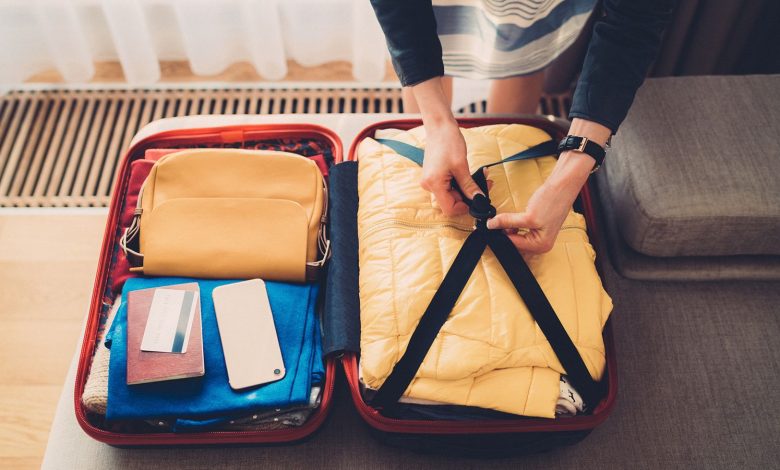The best carry-on luggage of 2021

There are hundreds of carry-ons on the market these days, with offerings from both established luggage brands and newcomers hoping to disrupt an expensive industry with affordable, high-quality gear. With tons of options to choose from, picking the right bag for your trip can be overwhelming. We’ve already tested the best checked luggage for your travel plans. Now, after researching dozens of cases (reading through both editorial and user reviews), we zeroed in on 12 of the most popular luggage bags with especially high praise from reviewers, and then put them through the ringer to determine the best carry-on suitcase.
We focused exclusively on hardside luggage, as in our experience this has proven to be the best at actually protecting your stuff. New materials mean today’s hardside luggage is also often incredibly lightweight and flexible enough to pack to the brim. We also only tested four-wheel spinner cases, as these are generally easier to maneuver than two-wheel cases (and any difference in packing space is negligible).
After weeks of testing, we’ve settled on four cases that will serve nearly any traveler’s needs. Take a look at our picks, rationale and testing process below.
Best overall hard-shell carry on luggage
A luxurious hard-shell runner-up choice
The most Instagrammable hard-shell carry-on luggage
Best affordable hard-shell carry-on luggage
Best overall hard-shell carry-on luggage: Away Carry-On ($225; away.com)

The Away Carry-On has everything you want in a suitcase: durability, thoughtful organization, smart features and chic design — at a fair price point to boot.
It tied with the Delsey Chatelet for the highest overall score from our testing, even before accounting for the fact that it’s lower priced than its high-end competitors. Away’s offering stood up very well to our abuse, handling being kicked, jumped on and dropped down stairs with only minor scuffing and zero lasting dents. This is due to the materials it’s constructed with: The outer shell is 100% polycarbonate, an extremely strong yet lightweight and flexible material that’s become the gold standard for hardside luggage.
Away also utilizes smooth YKK zippers, an aluminum telescopic handle and the Rolls-Royce of luggage wheels: four double Hinomoto spinners, which in our testing glided seamlessly on pavement, hardwood and grass alike. The bag also never felt like it was going to tip over, even when fully loaded.
To be fair, Away’s top and side carry handles are a bit flat and stiff — a minor issue since the bags will typically be rolled rather than carried, but an issue nonetheless. The telescopic handle was also one of the wobbliest we tested. That said, Away claims the handle is meant to be this flexible to better absorb shock, and no issues with the handle actually arose in our testing. We also liked that the handle itself is black rather than the brushed steel color typical of most cases, as this better matches the trim and detailing on the bag.
Away really shines, however, when it comes time to actually pack it. The case features the best internal design of the bunch — a simple yet effective system that will keep your stuff organized without overcomplicating things or clogging up valuable packing space. One side consists of a deep pocket covered by a full-zip divider, good for hard or bulky items; the other side is topped by a removable, buckle-down compression board that helps you wring every bit of space out of the 39.8 liter bag. The compression board also features a larger zip pocket that’s the perfect size for sliding your laptop into it; since the board is meant to sit atop your clothing, this automatically offers extra padding for your delicate electronics.
Thoughtful touches like this helped push the Away into our top spot. For instance, a lot of bags also feature clamshell designs with one fully zipped side and one with some sort of strap to hold clothing down. But with the Away, that zippered side has a mesh covering, meaning you can actually see what you’ve packed without having to dig around in your bag. The inclusion of a hidden, water resistant laundry bag and leather luggage tag are nice touches as well.
Whether or not you want a smart suitcase is a matter of preference, but it’s nice to have the option. Away was the only case we tested that actually comes with a battery pack (a 10,000 mAh travel-friendly charger, to be precise). It also has the easiest battery removal process of the cases tested by far, since you can simply pop the battery out of the case while it’s still shut. The case also has two charging ports, whereas all but one other we tested (the Genius Pack Supercharged) had only a single port.
At 8.1 pounds, the Away certainly wasn’t the lightest bag in our testing, but we think the extra (literal) baggage is a fair trade-off given everything else you get. And if you’re positive you don’t want a smart suitcase, just purchase the Away without the battery pack to save a little weight.
Finally, Away’s lifetime warranty and free and easy returns for 100 days shows that the company stands by its product. And, of course that product looks fantastic: With a sleek design and nine tasteful color options (plus frequent limited-edition shades), you can pick something that won’t look like every other black suitcase on the conveyor belt.
If you think you’ll be returning from a trip with a ton of souvenirs, it’s worth considering grabbing an expandable case like the Calpak Ambeur, or upgrading to Away’s Bigger Carry-On (bearing in mind the risk that this might meet all international carry-on requirements). Otherwise, the Away Carry-On is the hardside suitcase we’d reach for most. As essential as a good travel pillow, this bag will serve almost all travelers’ needs for years to come, and will look fantastic while doing it.
Runner-up hard-shell carry-on luggage: Delsey Chatelet Hard+ 21-Inch Spinner ($256, originally $321.48; amazon.com)

As noted above, the Delsey Chatelet Hard+ 21-Inch Spinner actually tied in our testing with Away’s case. The Chatelet got especially high marks for durability, thanks to its Bayer virgin Makrolon polycarbonate shell, Hinomoto wheels and aluminum handle. The outer shell is thicker and has less give than Away’s — making the case heavier and less flexible overall, but also less dent-prone. In fact, the Chatelet essentially ignored all our attempts to damage it. The shell also has a lightly textured diamond pattern meant to reduce the appearance of scratches and scuffs, and it was indeed more scuff-proof in our tests than the Away.
This was also the most luxurious-feeling case of the bunch. Inside features soft-touch polyester lining and super smooth zippers with faux leather pull tabs. The top and side handles are also wrapped in cushy faux leather, making them quite comfy to hold for long periods of time. The wrapping on the handles is thick, though, meaning it’s hard for other items to lay flush atop the case — an issue for those who like to stack tote bags or pet carriers on top of their luggage while rolling through the airport.
Delsey’s telescopic handle deserves particular praise: It’s shiny, black and remarkably smooth — so smooth, in fact, that we couldn’t give any other case’s handle a perfect score after using it. The Chatelet also features an easy brake system, which proved useful when stopping on a sloped surface or when carrying the case on the subway.
The Chatelet features a classic, glamorous design. There are only three color options available, but there’s no denying that this bag looks and feels high-class. It also comes with a laundry bag, shoe bag and collapsible hanger. Inside features two compartments with tie-down straps and full-zip dividers; it’s a fine system, but we preferred being able to actually see what we’ve packed with Away’s mesh zipper compartment.
The Chatelet doesn’t have as great a warranty as the Away, though it’s still very solid at 10 years. The Chatelet also comes with a built-in tracking plate you can register online in case it’s lost or stolen.
So what’s the problem? The Chatelet is 9.3 pounds — nearly 1.5 pounds heavier than Away’s Carry-On, and more than 3 pounds heavier than the Calpak Ambeur. And in the world of excess baggage fees, weight reigns supreme. The bag also has an enormous internal capacity with 44.9 liters of space, but is physically bulkier than the Away. While the Chatelet should be fine for domestic travel, you could run into trouble when trying to carry this bag onto certain international flights. It’s always worth checking an airline’s posted carry-on dimensions before traveling.
If you’re not planning to bounce around between many locations on a trip, or if you’re traveling by car or train where weight isn’t a concern, then the Delsey Chatelet is still certainly worth considering. It’s a joy to use, with a huge capacity, smooth wheels, sturdy shell, and that fantastic telescopic handle. Above all, the Delsey Chatelet will make you feel like a first-class traveler, even when you’re stuck in coach.
The most Instagrammable hard-shell carry-on luggage: Calpak Ambeur Carry-On ($156, originally $195; calpaktravel.com)

The Calpak Ambeur is a seriously gorgeous bag that clearly had a lot of thought put into its design details. Its sleek, monochromatic exterior is endlessly Instagrammable, and even the wheels and telescopic handle match the rest of the case. The Calpak Ambeur also had some of our favorite top and side handles of the bunch, with a squishy cushioned grip that made for an ultra comfortable carry. To top things off, the bag is also exceedingly light at just 6 pounds.
Overpackers will be happy to know that the case expands up to 2 inches, bumping its potential capacity to a whopping 46 liters — even more than the Delsey Chatelet, but in a sleeker package. The downside of expandability, of course, is that you might inadvertently surpass size and weight restrictions on some airlines. The expandable part of the bag is also made of fabric, which is inherently less durable than the hard shell itself.
Calpak’s shell isn’t entirely polycarbonate, and it was more prone to dents and scuffs than the Away and the Delsey. Some reviewers also report issues after a few months with cracking, dents and broken wheels, though we didn’t experience any of this ourselves during our testing. The interior is also a somewhat crinkly polyester (though the rich blue color is lovely), and the internal zipper was prone to snagging. The warranty is also just two years.
Overall, though, this is an exceedingly stylish bag that will fit a ton. If you’re shopping for a case under the $200 mark and don’t plan on regularly kicking it down a flight of stairs, the Calpak Ambeur is a solid choice.
Best affordable hard-shell carry-on luggage: Samsonite Omni PC Hardside 20-Inch Spinner ($109.99, originally $149.99; amazon.com)

Polycarbonate is among the best hardside suitcase materials, but you’ll usually have to pay a premium for it. Not so with the Samsonite Omni, which has a fully polycarbonate shell yet can be snagged for about $100. The micro-diamond texture is similar to that of the Delsey Chatelet, and prevented any serious scuffing in our testing — without Delsey’s bulk. The Omni weighs just 6.8 pounds and has a huge 41-liter capacity. This is a very sturdy bag with plenty of space, and also comes with Samsonite’s 10-year warranty.
The internal organization is pretty bare-bones, with one deep mesh divider, a small accessories pocket and a containment strap that proved a bit tricky to snap open and closed. This also isn’t nearly as stylish as our top three bags, but that’s certainly not a dealbreaker for many travelers.
What was a concern for us, though, was the Omni’s lack of a horizontal side handle. This handle really comes in handy when lugging a case up and down stairs and when removing it from an overhead bin, and its absence is a disappointing oversight here. The wheels are also single, rather than double, spinners, which are slightly less sturdy and more prone to getting caught in cracks in the sidewalk.
The Samsonite Omni still makes a solid budget carry-on, however, because it does exactly what a suitcase is supposed to do: fit lots of stuff, and keep that stuff safe. It’s lightweight and sturdy, comes from a trusted travel brand, and is a good value given its materials.
How we tested
Suitcases need to be able to withstand a fair amount of abuse, fit a lot of stuff, and roll without a hitch. We broke up all the factors that matter to travelers into categories, and then evaluated how each case held up.
Materials and durability
- Outer materials: We assessed the materials used in each case’s outer shell, zippers, telescopic handle and wheels.
- Internal materials: We felt the materials used in the lining of cases for softness and stretched and bent any internal compression straps.
- Dent and scuff test: We jumped on the cases. We kicked the cases and whacked them with hammers. We tossed the cases down a flight of stairs, much to the annoyance of our neighbors. Then we assessed how busted up each bag looked, as well as how easy it was to wipe away scuffs and pop out dents.
Capacity and Organization
- Internal volume: We measured the packable interior of the bags and also noted reported capacity in liters while making sure they met carry-on size limits.
- Packing experience and organization: Just as important as capacity is how the space within a bag is actually used: Is the organization overwhelming, nonexistent, or just right? We assessed the utility of any internal pockets, straps, and dividers. Then we actually packed and unpacked the bags with the same set of items, noting how easy it was to keep our things organized, shove in last-minute items after closing the case and get at things once the case was reopened.
Performance
- Weight: We weighed the bags (unpacked).
- Maneuverability: We rolled the bags across carpet, hardwood, cracked pavement and grass, and assessed how quietly, steadily and smoothly each bag moved.
- Top and side handle comfort: We carried each bag up and down a flight of stairs using both handles, and assessed the comfort of each bag’s handle grips.
- Telescopic handle comfort and stability: We raised and lowered the handle, and wiggled it around to assess wobbliness. We also used the handle to drag each bag, fully upright and as well using only the two front wheels, around the bumpy streets of Brooklyn.
- Smoothness of internal and external zippers: We zipped and unzipped multiple times, with the bags both packed and empty, and noted any snags or resistance.
Style
- Multiple color options: We researched how many color or design options are available for each bag’s outer shell.
- General impressions: We assessed the bag’s general look and vibe, as well as any options for customizability.
Additional Features
- Charging: We noted whether each bag had charging capabilities, and, if so, how easy that charger was to connect and remove and how many ports the case had.
- Expandability: We noted whether, and how easily, the bag could expand.
- TSA locking mechanism: We noted whether the bag had a TSA-approved lock, and also how easy this lock was to both set and use.
- Other extras: We noted whether the bag came with meaningful extras — like included laundry or garment bags, luggage tags, brakes or electronic tracking systems.
How we rated
We gave each bag a score in all of the subcategories listed above, and then added up those scores for an overall rating. Because certain factors are more important than others when it comes to choosing the right travel bag for you, we weighted our various categories accordingly; style, for instance, had less of an impact on a bag’s score than durability. Here’s how we broke down the points:
- Materials and durability were worth up to 15 points: feel and composition of outer materials (5); inner lining (5); resistance to dents and scuffs (5).
- Capacity and organization were worth up to 15 points: internal volume (5), packing/unpacking experience (10).
- Performance was worth up to 20 points: top and side handle comfort (5), telescopic handle comfort and stability (5), smoothness of internal and external zippers (5), maneuverability (5).
- Style was worth up to 10 points: number of color/design options (5), general impressions (5).
- Additional features were worth up to 10 points: charging potential (3); expandability (3); TSA locking mechanism (2); break system (1); extras (1).
- Having a warranty was worth up to 3 points: greater than five years (3); two to five years (1); bags with no warranties or warranties under two years did not get any additional points, since ideally you wouldn’t be needing a new suitcase that often.
- In addition to the above, we also factored in the price and weight of each bag.
A note on rankings: Differences in volume and materials were often so minor as to be negligible. An extra liter of space or a few ounces of weight here and there aren’t going to make a meaningful difference for the average traveler. Some cool features also have downsides. Expandable cases are obviously going to offer you more room, but that comes at the cost of potentially tipping the scale for what’s allowed in your carry-on bag (not to mention the fact that the expandable portion of the case is less durable than the rest of the shell). Charging, too, is really a matter of preference.
That’s not to say that some bags aren’t significantly better bets than others. It’s just to remind you to think about how you’ll actually be using a piece of luggage before getting too bogged down in very minor differences that probably aren’t going to affect your travel experience.
Finally, a note on polycarbonate vs. ABS outer shells. If you’re curious as to whether polycarbonate is really worth the major jump in price, the answer is usually yes. It’s not only more durable, but it’s also lighter and more flexible than ABS. That means you can often squeeze a few more things into the case, that dents pop out more easily, and that you can trust that your bag isn’t going to crack in baggage handling.
We ultimately considered each bag with all of the above in mind, taking care to determine what factors would really matter to the most travelers.
Other luggage we tested
Paravel Aviator ($350; tourparavel.com)

We loved the Aviator’s internal design and compression system, which is actually quite similar to Away’s. We also loved that the Aviator is made from recycled materials and looks like an old-timey trunk. We’d be happy to use this case, but it lacks Away’s lifetime warranty and charging capabilities, despite being about the same weight and more expensive. If price isn’t an issue and you don’t care about smart features, or you’ve simply fallen in love with the look of the bag and Paravel’s mission, it’s still a good pick.
Delsey Aero ($98.99; amazon.com)

The Aero is another case that performed well in most of our tests and had a huge capacity. The super shiny exterior was also somewhat prone to scratches, however, and the case itself was rather heavy and bulky compared to our top picks.
Genius Pack Supercharged ($238, originally $395; geniuspack.com)

This is a very lightweight bag made from excellent materials and which fits a lot. All that said, we weren’t a fan of Genius Pack’s built-in packing cubes. We will always advocate for simple internal organization so you’re never limited in exactly how you want to pack your bag. It’s easy enough to invest in your own packing cubes and then just take them out of your luggage as you see fit, which you can’t do here. The Genius Pack also lacks the lifetime warranty of Away, yet is about the same price, and the telescopic handle had more resistance than the other bags.
Travelpro Crew 21 Inch Spinner ($199.99, originally $229; travelpro.com)

The Travelpro Crew 21 is a sturdy, lightweight option from a trusted brand. Alas, the case’s sloped top was a dealbreaker, as it prevented us from stacking a tote or pet carrier on top of the case while rolling it. We also disliked the uneven packing space inside (with one side much shallower than the other), and the flap covering the USB port was somewhat frustrating to close. The top and side handles were also very tight to the case, making it hard to slide our hands through.
Rimowa Essential Lite Cabin ($560; rimowa.com)

This beautiful bag is truly, shockingly light. But for this price, we’d want something perfect, and unfortunately this isn’t. There’s no side carry handle, and the single barred telescopic handle, while space-saving, put a major strain on our hand when dragging the case behind us.
Briggs and Riley International Expandable Spinner ($463.20, originally $579; briggs-riley.com)

This bag excelled in our durability tests, and features both a fantastic warranty and beautiful craftsmanship. The internal compression-expansion system is pretty cool too. What we didn’t like, however, was the disparity in packing space once you open up the bag. One side is much deeper than the other, which resulted in more layers when packing — and meant more digging through our stuff to find anything once the bag was opened.
Fortis Pro USB Spinner ($159.99; ebags.com)

A super durable bag that suffered from the same misstep as the Genius Pack Supercharged: There’s just too much going on inside. The built-in packing cubes are oddly placed, to the point that packing and unpacking were rather tedious. The flap covering the outer USB port was also flimsy and maddening to close.
American Tourister Moonlight Hardside Expandable Spinner ($104.99, originally $124.99; amazon.com)

At its sale price, the Moonlight isn’t a bad value. It has lots of packing space, a simple yet useful internal design and tons color and design options. But this bag also dented and scuffed very easily when jumped on (it’s entirely ABS rather than polycarbonate, which certainly had something to do with that). The outer coating quickly crinkled up, and marks remained quite visible after any dents were popped back into place. Part of the draw of this case is its looks, but you can’t expect it to stay pristine for long.
AmazonBasics Hardside Spinner ($74.99; amazon.com)

Though very affordable, this was our least least favorite case. It’s a “basic” case, and it sure feels like one. This, like the American Tourister case, features a less durable ABS shell that dented quickly and retained lasting marks after our tests. Inside is lined with a very crinkly polyester, and the expandable side is also the side with a full zipper divider — an odd design choice that made packing less efficient. To use the case’s full capacity, you have to basically zip it shut, and then pile things awkwardly on top of that zippered compartment (which also oddly wasn’t flush with the outer edge of the bag). Overall, we’d rather shell out for a more expensive case that will last longer and feel nicer to use; travel is uncomfortable enough as it is.






